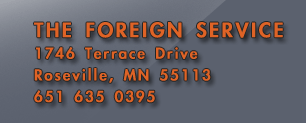

  |
| HomeAbout UsContact UsForeign Car ServicesCarsLoanersFAQTowing |
|
FUEL ECONOMY Fuel
economy complaints can be hard to resolve, usually because they
originate from multiple causes. My rough analysis is that you can
break the causes down into three main groups: Maintenance,
Operation, and Design. Maintenance The biggest maintenance problem we see here is tire pressures. I don't have any statistics, but I can say from experience with my electric truck that from the standpoint of fuel economy, you want the tire pressures as high as possible. And, running them at lower pressures has a huge effect on increasing rolling resistance, which reduces fuel economy. Tire pressures should be checked when "cold". This means that the car has not been driven for a couple of hours, and are not artificially heated by anything--like strong sunlight, or a heated garage in the winter. Somewhere on the sidewall of the tire is a rated maximum cold pressure; do not ever exceed that pressure! Passsenger car tire maximum ratings tend to be either 36 or 44 psi. We set most tires at 36psi during servicing here. If you have tires rated for 44, you it is OK to fill them to that higher pressure. The only down side is that the ride may get somewhat harsh. Only very rarely do we see problems with tire wear from overinflation. I run my Prius at 44 psi, and have no tire wear issues. (I also had to do a four wheel alignment as soon as I took delivery of it, but that's a different story.) The next maintenance item is regular maintenance on the engine, especially the air filter. For most of my customers, checking the air filter (and probably replacing it) should be done about once a year. Also under the maintenance category, we can calibrate your speedometer. What is the point of even keeping track of your fuel economy, if you don't really know how fast or how many miles you are driving! Calibrating the speedo is very cheap and easy and you can do it yourself with a hand held GPS unit if you have one. Operation Try changing your habits one at a a time; I suggest the following order. Step one: Become aware of the speed you are driving. Watch for speed limit signs and recheck your speed at each one. If you have little kids, this can be used as a fun game. Step two: Keep your speed steadier. Don't allow yourself to be sped up and swept along with the faster drivers on the freeway. Step three: Try to adhere to the speed limit on the highways. Fuel economy decreases with speed. If you have to, set your cruise control to the speed limit and then you will be a standard out there on the roadways. Step four: Learn how to "coast". When you coast, you lift your foot slightly off the accelerator, but not fully. On a level road you will decelerate only very slowly. You can anticipate stop lights and stop signs several blocks ahead and use virtually no gas to drive those two blocks. Step five: Accelerate more slowly. I like to imagine that I have an open cup of coffee on the seat next to me and I am trying not to spill it by taking off too fast. Following these steps will make you a more aware driver, and more aware is more safe! Design You don't have very much control over the design of your vehicle, but you certainly have control over what design you buy! It seems that many of our vehicle choices seem to be based on what we might someday like to have instead of what fits our needs most of the time. With a growing national awareness of the dangers of using so much fossil fuel, consumers are demanding more fuel efficiency. Expect the next several years to bring big changes to the kinds of cars available, and big changes in their fuel economy. It can be confusing to try to assess what kind of mileage you should expect from a new/used car purchase. I have found some answers in forums and user groups. I was asked to check into the poor mileage one client was experiencing with her Sienna. By digging into the Sienna forums, I discovered that the mileage she was getting was very typical of what others got and that none of them were very happy about it!
|
|||
|
||||